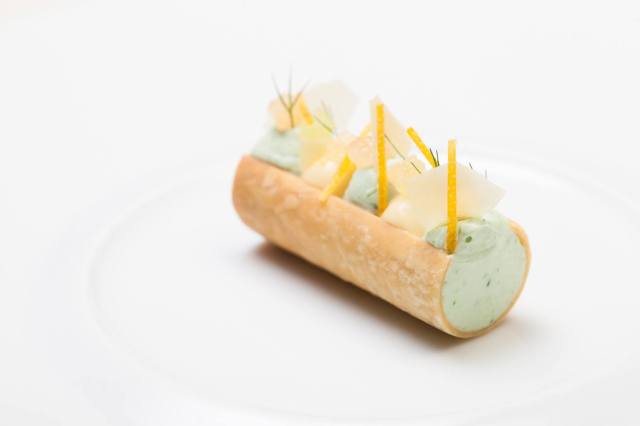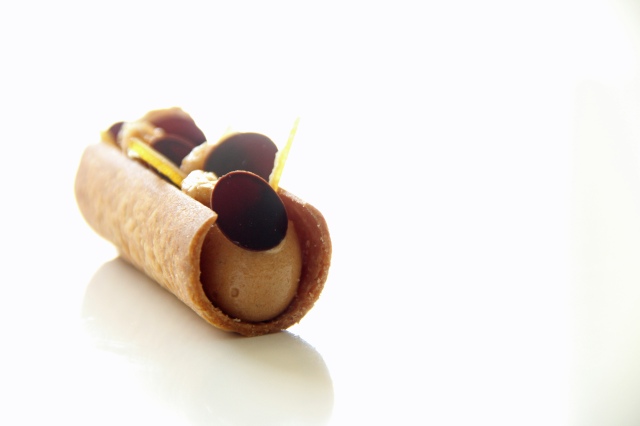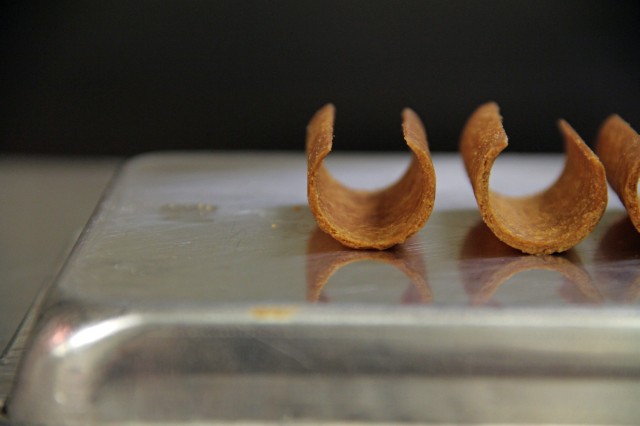The light and flaky pâte croustade long ago entered my repertoire as a go-to dough preparation for savory tarts. Beyond that, I didn’t think of it much until it resurfaced as a solution to a three-fold ‘problem’, a moment of inspiration:
1. In general, I’m always thinking about reducing sugar where appropriate – not out of altruistic concerns about health and wellness, but rather in service of flavor. While sugar can be a great vehicle for flavor, sweetness can also obscure it.
2. More recently, I’ve also been thinking a lot about ‘reconstruction’. The dominant style of plated desserts these days still seems stuck in the rut of ‘piles of stuff’. It’s a pleasant aesthetic, but I’m starting to feel that it’s too easy. Where can we take it next? How can we put things back together in a way that ‘eats’ better, but also challenges the chef to move beyond this stylistic crutch? How do we clean up our plates and still manage to arrange these flavors and textures in an interesting way?
3. One of my favorite pastry chefs to keep tabs on is Christophe Michalak – like Pierre Hermé, he represents a great balance of contemporary and classic with work that is clean, precise, and to-the-point. About a year back I saw something he referred to as ‘tartelette slim‘ – a seemingly impossible, near-cylindrical tart shell. Here was an idea that both changed the notion of what form a ‘tart’ could be, but also presented an interesting vehicle to re-assemble components in a more ‘constructed’ way.
I never came across a formula for the specific dough Michalak used in his version (to be honest, I didn’t look all that hard), but I knew the challenges would be in finding a way to form the cylindrical shape, and then adapting a typical pâte sucrée/brisée that would hold its shape in the baking process. I immediately ruled out anything with a substantial amount of sucrose – the appealing tenderness it provides in every other dough would be a serious structural disadvantage here. And then I remembered that pâte croustade – it’s capable of being rolled extremely thin, it can be formed into various shapes without shrinking or falling apart, and it’s lack of sweetness also appealed to my flavor forward sensibilities.
The dough is a bit strange – whereas most flaky doughs require cold temperatures to keep small discrete pockets of fat from coalescing, this dough is assembled with melted butter and warm water. Indeed, the end result of mixing often resembles a broken – if not outright greasy – mass. But it is that very ‘broken quality that creates a fine flaky texture after chilling and sheeting. After a couple of years of not making it, the croustade has re-emerged as one of my favorite doughs to work with.
We used to fashion tiny croustade ‘tacos’ as a canapé at Le Bernardin – draped over stainless steel tubes (cannoli forms, actually) and baked – so the problem of form was also solved. When looking to achieve such geometric precision, the smallest things can throw that precision off; I’ve found that cold working temperature and ample resting between the steps of sheeting, cutting, and baking to be crucial. In addition to exact measurements, another challenge was keeping the cylinders stationary during baking; a tight wrap in foil not only holds the dough in place, but foil cut to a specific length can allow for the slack to rest under the narrow gap between the edges of the dough – this prevents the foil from unraveling and the tube from rolling around in general.
The first iteration of this ‘tart’ appeared with my collaboration in the kitchen at L2O, with wintertime flavors of citrus and fennel (below). A more recent version forms a vehicle for milk chocolate and hazelnut (above).
Below, the recipe for the base dough, and the general dimensions necessary to produce the thin 3/4 cylinder shells:

Image Courtesy of L2O



These ‘taco’ shapes are quite elegant, and I might take a stab at the dough and forming. How do you get the filling to end so cleanly on the end of the crust? Is it overfilled and trimmed? Wrapped in plastic and filled? Thanks!
Brice – yup, slightly overfilled and cleaned with an offset.
Brilliant recipe, it worked like a charm! Thank you.